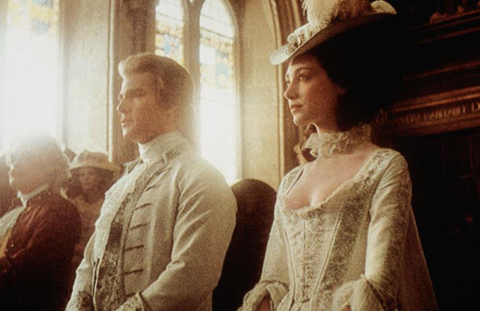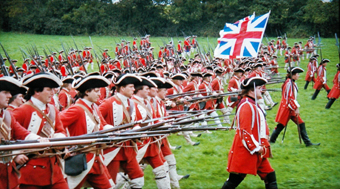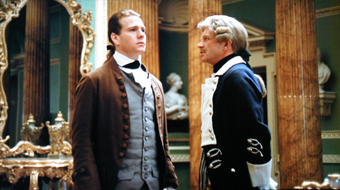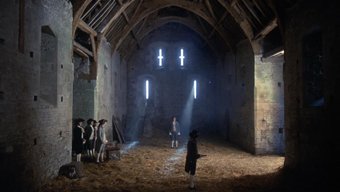
Barry Lyndon:
A Look Back at a
Stanley Kubrick Classic
| published September 3, 2017 |
By R. Alan Clanton,
Thursday Review editor
In the annals of Hollywood time travel, there have been a dozen or so truly impeccable films that have nearly perfect fidelity to both atmosphere and palette, that is to say movies that do not succumb to contemporary musical or artistic trends, political correctness, or hipster shooting styles.
Think of Michael Mann’s 2009 Public Enemies, which starred Johnny Depp and Christian Bale (as John Dillinger and Melvin Purvis, respectively), and which had as its primary fault not the atmospheric look and texture, nor the period costumes and vehicles and locations, but a shooting style and composition seemingly at odds with the historical backdrop—hand held camera work, deliberate shaky-cam, fluid first-person shooting, tight over-the-shoulder shots and herky-jerky medium-close-ups which bear as their lineage processes developed for the rapid-fire, fast-turnaround world of television, not the grandeur and wide-screen art form of the cinema. Call me old fashioned (and plenty of people do), but I want my historical period pieces to look and feel like history, not last week’s TV schedule.
This is not to say that Public Enemies is a bad film—in fact, it is wonderful. But the stylistic visual composition and ragtag, sometimes erratic, sound quality put it at odds with its archival historical tableaux. The same argument can be made about other recent attempts to delve into classically-understood period subjects: The May 2013 incarnation of The Great Gatsby, directed by Baz Luhrmann and based on the 1925 novel by F. Scott Fitzgerald, while lavish and dazzling, also crossed this line with shattering, often unpleasant results, not the least of which was Jay Z’s musical score and arrangements which included rap, hip-hop, electric hard rock, and disco-funk—hardly a comfortable fit with a story set in the pre-Depression world of Long Island and New York City.
This isn’t to say that breaking the period plane, as it were, is never allowed. It can be effective when executed smartly and skillfully, as Luhrmann himself did in the 1996 version of Romeo & Juliet, whereupon the story of the Capulets and the Montagues has been neatly grafted upon the modern day “Verona Beach,” a Miami/L.A.-like city of night clubs, high rise apartments, gas stations, record stores, urban tattoos. In place of long-knives and swords, 9mm pistols and automatic weapons abound, and the street level “family” members—which are extensions of two rival Mafioso gangs—cruise the urban corridors in low riders and flashy convertibles. The majority of the film was shot in Veracruz and Mexico City, giving it both a lavish tropical texture as well as an urban sensibility. And though Luhrmann took a few small liberties with the Shakespearean characters (there is no Friar John), the movie works despite the shocking transformation of place and time. Why? Because the transference was total, not partial. The viewer has no need to adjust their eyes or ears for the cultural displacement, and nothing forces us to recalibrate with every jarring set-piece innovation.
But on the whole, period pieces should stick to the period in which they take place. Which brings us to my subject: the 1975 release of Stanley Kubrick’s Barry Lyndon, one of Kubrick's most overlooked masterpieces.
I plan to offend a lot of fans of the great period piece American and British film right up front: Gone With the Wind is not the best of this genre. The most impressive period piece movie from the pantheon of great period movies is Kubrick’s sumptuous rendering of Barry Lyndon, the film based on the sprawling 19th century novel by William Makepeace Thackeray.
Kubrick was a perfectionist, a well-known obsessive perfectionist with a particularly good eye for both understatement and grandeur, two attributes—despite the intuitive reaction that these elements could easily cancel themselves out—which, when executed with skill make for dazzling results. Other directors with this canny ability have included Francis Ford Coppola (Apocalypse Now; The Godfather Part 2), John Huston (Chinatown), and John Ford (Stage Coach; My Darling Clementine). Kubrick, however, may be in a class by himself in this regard.
Kubrick’s most notable film achievements include the black comedy Dr. Strangelove (considered by some to be the best Cold War film ever set to the screen), Full Metal Jacket (a powerful, decidedly anti-war rendering of the lives of a group of U.S. Marines during the Vietnam War), and 2001: A Space Odyssey (widely held in esteem as the greatest science fiction film ever produced). Kubrick is also noted for his stunning rendering of A Clockwork Orange, based on the 1962 novel by Anthony Burgess, and The Shining, the director’s still controversial interpretation of Stephen King’s epic horror novel. (The Shining is widely beloved by film buffs and film students with no particular affinity for King’s macabre storytelling; but by contrast, The Shining is generally loathed by the dedicated fans of King’s novels and novellas. Kubrick chose to make the story his own, alienating some avid Stephen King readers forever).
Barry Lyndon, by contrast, gave Kubrick an opportunity to tackle a sprawling, classical work of fiction set in the 18th century, a story which has as its footprint locations in Ireland, England, France, Germany, Belgium and Holland. Flush off the success of his two previous masterpieces (Clockwork Orange and 2001: A Space Odyssey), it also gave him the latitude and freedom he needed to tackle a big-budget period piece with appropriate emphasis on tone, texture, and most importantly, detail.
The plot of the film is complex and circuitous, but never confusing. The movie starts, and ends with, a duel—the first involving the protagonist’s father, who is killed immediately; the last pitting the same protagonist, then well into advanced middle age, against a nemesis. Early in the film, still another duel results in the main character fleeing his home and his small Irish town—a seemingly temporary chapter which in fact alters his life forever.
Barry Lyndon tells the tale of Barry Redmond (Ryan O’Neal), a young man of modest means who loses his father in a duel. Adored by his doting mother, Barry works hard while dreaming of bigger things, but soon falls in love with a seductive but manipulative cousin, Nora. Nora, as it turns out, has her eyes on trading up, as it were, in a courtship with a pompous but well-to-do English officer named Quin (played by Leonard Rossiter). The two parallel courtships eventually collide in confrontation, and when Barry learns that Nora is to wed the officer, a challenge is made, and a duel arranged. After a variety of family members plead with Barry to forget Nora and cancel the duel, and after Barry rejects all forms of compromise, the gunfight ensues. Barry kills the officer, is sent quickly home by his cousins to pack, and rides off for Dublin “’til things quiet down.” Along the road to Dublin, Barry is robbed, losing all his money and his horse, and—unable to return home—joins the British army for the reliable pay, the promise of meals, and glory fighting in what would later be known as the Seven Year’s War, a conflict involving the armies and navies of more than a dozen countries.
But the “killing” of Quin, we soon learn, was a mere ruse to get Barry away from his hometown long enough for Nora and Quin to wed. Quin’s death in that pivotal duel was faked. Barry’s unit (he has been joined by his mentor and friend, an uncle) then goes into battle against a French unit, with the tragic result being the death of his uncle, Captain Grogan (Godfrey Quigley). Barry, like thousands of other soldiers, learns the painful lesson that war is not all glory and accolades, nor an exercise in character building. There is loss, there is death, there is despair.

With Barry feeling his life on an even faster downward spiral, he steals an officer’s uniform and papers, deserts his British unit, and attempts to flee to a neutral country. Along the way he encounters Prussian troops—allied at that time with England—and, given the choice of arrest or volunteering, is folded into yet another country’s army now fighting along a different European front in the protracted war. Barry, however, endears himself to his unit’s leader, Captain Potzdorf (played by Hardy Kruger), who eventually mentors Barry and—after Barry saves he captain’s life in battle—gives the younger man an opportunity to rise above his past troubles. At war’s end, Potzdorf enlists the English-speaking Barry to engage in some spy work for a powerful police chief. The chief and Potzdorf suspect that a gambler, the Chevalier du Balibari (Patrick Magee), is posing as either a French or German man of wealth, but may in fact be little more than a spy for the British or some other foreign power. Barry’s mission is to offer his services as a paid servant, then report on the Chevalier’s comings and goings to Potzdorf. But Barry quickly bonds with the Chavalier, who we learn is from Barry’s home country of Ireland, and the two men develop a counterplot, eventually escaping the scrutiny of the police and leaving the country. They live a modestly profitable but rootless life as professional gamblers, travelling from one well-appointed mansion to the next in search of willing, rich patrons.
It is here that Barry’s fortunes change most dramatically. At one lavish card party, Barry falls in love with the rich (and much younger) wife of an aging, unwell, wheelchair-bound septuagenarian—Sir Charles Lyndon, a powerful man with a guarded eye for the beautiful wife less than half his age. Played by Marisa Berenson, the woman is smitten by Barry’s unapologetic attentions, and the two set about having an affair of sorts, more-or-less in plain sight—angering the phlegmatic, dour husband. Later, when the old man dies of a heart attack, Barry immediately weds the heiress, thus securing his place in the highest of society by marrying into a river of old money and securing the money he has always felt his gentlemanly manner has demanded. The couple have a child, and Barry (who has now renamed himself Barry Lyndon, after the family name)—at the peak of his fortunes—has affairs. His spending increases in tandem with his newfound love of luxury, and he finds himself reveling in the best comforts that money can attain. He also becomes a doting father to their young boy.
But, as we all know from such classical morality tales, this life is to be a bell-shaped curve. A bitter rivalry has already ensued between Barry and his stepson (Lord Bullingdon, played by Leon Vitali), a brooding teenager, and later a young man who resents his stepdad’s oafish tentacles in his family’s legacy and fortunes. Bullingdon and Barry—always at war psychologically—eventually clash physically, whereupon the young Bullingdon effectively cuts himself off from his family and his mother.
A few years pass, and when the young child of Barry and Lady Lyndon is mortally injured after a fall from a horse, Barry’s downward spiral begins. Grief overcomes both husband and wife, Barry turning to drink. The family’s affairs fall slowly but inexorably into disarray even as the wealth is burned off. In the end, Barry is challenged in duel, this time with Lord Bullingdon, whose morbid hatred of Barry knows no boundaries. Bullingdon (there is a bit of a spoiler alert here) prevails in the duel in an odd moral twist at the very end of the film. Barry is left penniless and crippled, but—we are told by our narrator—begins to support himself as a small-time gambler. He has evaded death by duel, barely, unlike his own father who died when Barry was a child.
The ethical code and the moral reasoning—so bound by sharp class distinctions—within Thackeray’s original story remain complex, and at times difficult, for the more liberal readers of 20th century British and American literature to decipher at times. But not for Kubrick, who is able to make the story his own without damage to the classical novel. Kubrick also manages to thread into the fabric of the narrative one of his most durable and binding themes…the dehumanizing elements invented and imposed by society and by power, in this case—notably—war, but also stringent social structure and even family lineage (we learn that genealogical and hereditary advantages can be purchased, though it takes time and lots of money, which Barry is willing to spend). There is also the dehumanizing effect of sustained cruelty--first, that of Quin toward Barry, later that of the military life toward Barry, still later Barry's own selfish cruelties toward his wife, and stepson.

Kubrick also effectively sheds Thackeray’s story of its overdependence on the trappings of class and wealth, imbuing any such references instead with an ironic sadness. For all his dreams of being a man of wealth and class, Barry often seems dense, wasting money on paintings he does not understand and showering cash upon powerful people in an attempt to ingratiate himself on high society. Thackeray, author of classics such as Vanity Fair and Becky Sharp, already understood and wrote that wealth cannot buy happiness, but Kubrick effectively translates this ancient theme into an even more relevant context: wealth and power can often buy banality, brooding, and even controlled boredom. Money can also pervert, all-too-easily becoming a seductive path to loss of humanity and loss of soul—a theme consistent with Kubrick’s other film masterpieces (Full Metal Jacket, violence and war; Dr. Strangelove, industrial weapons and the power to destroy all life through war; A Clockwork Orange, social engineering taken to absurd extremes; Eyes Wide Shut, money, power, seduction).
Like Kubrick’s arguably most effective author-director cinematic fusion, 2001: A Space Odyssey (based on the classic sci-fi novel by Arthur C. Clarke), Barry Lyndon works well because of Kubrick’s attention to detail and his determination to make the film into something translatable to the modern movie audience. In the hands of a lesser director, Barry Lyndon could have become a festival of boredom at 24 frames per second, a grim, torturous movie about people in costumes. Instead, it is generally regarded a masterpiece, especially of the genre of the sweeping historical and period costume epic.
Kubrick succeeds with converting Thackeray’s novel to the screen as well through the director’s uncanny gift for pacing and skillful editing. Barry Lyndon—with John Alcott as cinematographer and Art Direction by Roy Walker and Ken Adam—may be the ultimate example of film as artist’s canvas: with meticulously timed scenes shot amidst impeccable costuming and surroundings and illuminated with such naturalistic lighting as to draw one inevitably into both mood and context. Indeed, Alcott, Walker and Adam have in interviews referred to how they took great pains to construct a film upon the visual framework of the paintings of Thomas Gainsborough, William Hogarth, and Jean-Antoine Watteau.
Kubrick—seeking to avoid the stagey “studio” look of most period films—was famously stubborn in his resolve to not use artificial lighting (battery or electrically powered) in any of the many interior scenes shot inside the deep halls and high-ceilinged rooms of various castles and mansions throughout Ireland, England and Germany. The challenge for the director was therefore nothing short of daunting: how to capture on film images and scenes inside rooms lit almost entirely by candlelight. Kubrick’s solution was to obtain a then-state-of-the-art Carl Zeiss lens (Zeiss Planar 50mm f/0.7), developed specifically for NASA for space exploration and the Apollo moon landings. The super-fast lens allowed for vastly improved light and image capture in dark settings. Designed for more-or-less for standard, wide-shots and scientific purposes, Kubrick had the lens and its mounting mechanisms modified in order to give him flexibility in tighter spaces, conventional rooms, and places of deeper, more nuanced color and diverse texture. The modifications gave the images warmth without sacrificing clarity. Kubrick and Alcott augmented this by carefully managing the film processing, “pushing” the developing process by one step. Then, in some scenes where the even the candlelight was too low, Kubrick reluctantly but skillfully employed only carefully filtered artificial light which could closely replicate candlelight or the glow from a fireplace.
The result was astounding, making Barry Lyndon the first major pre-electricity period piece to maintain fidelity in terms of lighting and composition. Indeed, the film never reveals its technological side nor succumbs to the powered, artificial light of the post-industrial age. Each sequence, each scene, each shot, is to travel into a literal moving picture—a painting which pays homage to the great artists of the 17th and 18th centuries. Gone was the staginess predominant in most other period films, and in its place was a motion seamless picture (literally) of life in the late 1700s.
Barry Lyndon also contains several impressive battle sequences, including one in which a battalion of British troops engage an equivalent army of French troops. Choreographed with meticulous detail, the sequence stands as one of the best cinematically staged battle scenes ever captured, and includes masterfully executed tracking shots across a wide tract of lush landscape. Compared with today's big-budget epics with their digitally created battle sequences and special effects driven fields of fire, Barry Lyndon is even more astonishing for its production via old school methods perfected by Kubrick, including lots of extras. Coupled with a remarkable breadth of on-location shooting—including in Ireland, Scotland, England, Wales, France and Belgium—the film stands as one of the most astounding, lush achievements of the screen.
Film histories and retrospective reviews of the movie have treated Barry Lyndon better than the film’s contemporary reviews, making it one of those rarest of films: one which seems to gain strength with time. After its release in 1975, though many critics praised the movie’s technical achievements, its grandeur and its lavish attention to detail, a few of those same critics suggested that Barry Lyndon was cold, detached, and—here we are full circle at what Kubrick did best—even bordering on dehumanizing, the latter a specific charge which Kubrick would not at the time deny. Still, the movie held its own, scraping out modest box office numbers and barely recovering its substantial $12 million budget (it made $20 million by the end of its first year). American audiences were lukewarm to the period piece during the same year as Jaws (which was released in the summer), One Flew Over the Cuckoo’s Nest, and Dog Day Afternoon. There were also other period pieces of lesser mettle: The Man Who Would Be King (which did better at the box), Day of the Locust, The Wind and The Lion, and even two period piece comedies, Woody Allen’s Love and Death, and Monty Python & the Holy Grail.
Though it was nominated for several Oscars, Barry Lyndon lost the Best Picture honors to One Flew Over the Cuckoo’s Nest, Milos Foreman’s powerful interpretation of Ken Kesey’s groundbreaking novel. But Kubrick’s classic movie still raked in well-deserved top honors for Best Art Direction, Best Costume, and Best Cinematography. It also won an Oscar for Best Musical Score for its well-crafted adaptations of a variety of classical music, notably Handel and Schubert.
The chemistry between actors is powerful, most especially between leads Ryan O’Neal and Merissa Berenson, neither of whom were deemed by film analysts and Hollywood observers to be the kind of actors typically cast by Kubrick. One critic noted during the development of the movie that O’Neal, in particular, was decidedly “un-Kubricky.” Nevertheless, the perfectionist Kubrick, well known for patiently and even obessively extracting performances of unusual quality and by way of exacting standards, worked well with O’Neal and Berenson. In addition, the film’s overall less-is-more quality and painterly design surely helped Kubrick achieve the goal of astounding, if at times effectively minimalist, performances from both the leads, and the legion of supporting actors, including Magee, Kruger, German-born Wolf Kohler, Steven Berkoff (as Lord Ludd), Philip Stone (as Graham), and Leonard Rossiter as Capt. Quin.
Barry Lyndon should also be required—and preferably uninterrupted—viewing for any serious or amateur student of film. Kubrick’s most stately and grandly executed film (save for the reasonable argument that his greatest classic was 2001: A Space Odyssey), it is also a masterpiece of pacing and editing—a methodically timed period piece which has never been described as boring despite its length and its classical tones. Also, if you plan to watch this film for the first time, make sure that you watch it wherever in its original widescreen format—and, if possible, in the highest definition available.
Related Thursday Review articles:
The Golden Age of Space: 30 Years After The Right Stuff; R. Alan Clanton;Thursday Review;
Francis Ford Coppola's Best Year: 1974; R. Alan Clanton;Thursday Review; December 22, 2014.
